![]()
![]()
![]()
Use LEFT and RIGHT arrow keys to navigate between flashcards;
Use UP and DOWN arrow keys to flip the card;
H to show hint;
A reads text to speech;
142 Cards in this Set
- Front
- Back
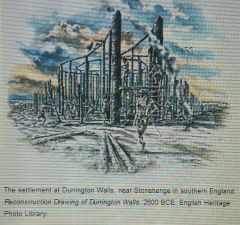
The settlement at Durrington Walls cannot be classified as megalithic architecture because the site was.....
|
built from wood, whereas megalithic structures are made of stone.
|
|
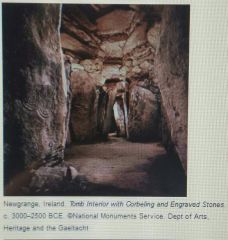
This structure can be classified as all of the following EXCEPT a...
|
dolmen, due to its funerary purpose and cairn, or artificial hill.
|
|
|
Which material's properties is most suitable for weapons and tools?
|
Bronze
|
|
|
Which Neolithic site is an example of a passage grave?
|
Newgrange
|
|
|
Relative to art, one of man's important new cognitive developments was the ability to...
|
think symbolically.
|
|
|
The word "Neolithic" means...
|
new stone.
|
|
|
Much of what we know about prehistoric people is based on the ________ found in archeological sites.
|
artifacts, art, and fossils
|
|
|
Homo sapiens appeared on the earth ______ years ago.
|
400,000
|
|
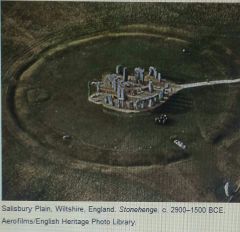
From this aerial photograph, it can be discerned that Stonehenge is built using....
|
post-and-lintel construction.
|
|
|
The word "Paleolithic" means...
|
old stone.
|
|
|
The Sculpted Bison at Le Tuc d,Audoubert, France are modeled in...
|
high relief.
|
|
|
Many megalithic structures are associated with...
|
death.
|
|
|
The Woman from Willendorf was created from _____.
|
limestone
|
|
|
______ is one if the earliest known sites of prehistoric cave paintings.
|
Chauvet
|
|
|
The word megalithic means _____.
|
large stone
|
|
|
The simplest form of construction used to span space is ____and ____.
|
post; lintel
|
|
|
Handprints at the cave at Pech-Merle were probably created using what technique?
|
Spray paint onto the cave wall.
|
|
|
Prehistory includes all of human existence prior to the development of ____.
|
written records
|
|
|
Representational images began appearing in Australia, Africa, and Europe beginning approximately ____ years ago.
|
40,000
|
|
|
Stonehenge is connected to a nearby site built of wood called ____.
|
Durrington Walls
|
|
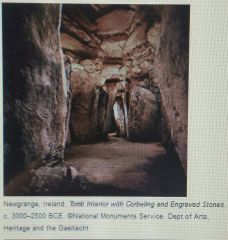
The construction method of corbeling, such as that used in the Tomb at Newgrange, involves...
|
rows of stone projecting slightly beyond the previous layer until the uppermost stones meet.
|
|
|
Prehistoric cave painting was an unknown art form until the 1879 discovery of a cave in ____ in northern Spain.
|
Altamira
|
|

What distinguishes this scene from other Paleolithic paintings discussed in this chapter?
|
It appears to tell a story.
|
|
|
The age of metal made its European debut around ____ BCE.
|
3,000
|
|
|
The animals at Lascaux are painted in a system known as ____, which shoes horns, eyes, and hoofs from the front, while heads and bodies are rendered in profile.
|
composite pose
|
|

What sums up the relationship of the image to the cuneiform text on the Stele of Hammirabi?
|
The image reveals the divine origins of the text.
|
|
|
The uppermost scene of the Carved Vessel from Uruk may represent ____ between the goddess and her consort.
|
a reenactment of ritual marriage
|
|
|
The relief sculpture of Assurnasirpal II killing lions probably depicts a ____.
|
ceremonial hunt
|
|
|
Mesopotamia sculptors told stories clearly and economically by organizing visual narratives in horizontal bands called ____.
|
registers
|
|
|
The Great Lyre with Bull's Head was found in a royal ____.
|
tomb
|
|
|
Sumerians used hard, rock ____ for identifying documents and establishing property ownership.
|
cylinder seals
|
|
|
The Ishtar Gate and the walls extended beyond were made from ____.
|
glazed bricks
|
|
|
The image of Gudea, the ruler of Lagash, is well known to students of Near Eastern art because of the twenty surviving ____ that he commissioned.
|
votive statues
|
|
|
Sumerian votive figures were dedicated to the ____.
|
gods
|
|
|
What subject was NOT depicted in the relief panels decorating Assurnasirpal's palace at Nineveh?
|
Scenes from the Epic of Gilgamesh.
|
|
|
The relief of Darius and Xerxes Receiving Tribute exemplifies Persian art's emphasis on ____.
|
allegiance and economic prosperity
|
|
|
Along with shell and wood materials ____ and ____ were used to sculpt the elaborate bull head on a lyre found at a royal tomb in Ur.
|
gold; lapis lazuli
|
|
|
The ____, which Darius built at Persepolis, was large enough to hold several thousand people.
|
apadana
|
|
|
Guardian figures, called lamassus, combined features from all of the following EXCEPT _____.
an eagle, a man, a horse, a god. |
a horse
|
|
|
Which of the following objects conveys both political and religious meaning?
>Stele of Naram-Sin >Nanna Ziggurat >Votive Statue of Gudea |
All of them
|
|
|
Known for his persecution of Jews, as recorded in the Hebrew Bible's Book of Daniel, Nebuchadnezzar II was responsible for transforming ____ into one of the most splendid cities of its day.
|
Babylon
|
|
|
____ were huge stepped structures surmounted by a shrine or temple.
|
Ziggurats
|
|
|
In the Stele of Hammurabi, Hammurabi stands in a gesture of ____ before the seated god Shamash.
|
prayer
|
|
|
The notched walls built as a part of military defenses are called ____.
|
crenellations
|
|
|
The Stele of Hammirabi is significant as both a work of ancient Mesopotamian art and as _____.
|
an historical document recording a written code of law
|
|
|
The Sumerians invented the first system of writing called ____.
|
cuneiform
|
|
|
The ruler, _____, conquered the Persian Empire in 334 BCE.
|
Alexander the Great
|
|
|
Sumerian votive figures possess ____ that reflect Mesopotamian devotional beliefs.
|
large open eyes
|
|
|
The most impressive surviving archeological remains of the Sumerians is the ____.
|
ziggurat
|
|
|
What original elements have been lost from the Warka Head?
|
A gold wig, the body, and inlaid eyes.
|
|
|
Imhotep, the first architect to be identified in history, designed....
|
Djoser's Funerary Complex.
|
|
|
All of the following were part of the mummification process used in ancient Egypt EXCEPT
> the body was covered with natron, a naturally occurring salt. >the body cavity was filled with linen soaked in herbs and ointments. >the major organs were put into jars placed in the tomb. >the skin was blackened with dark paint or powdered makeup. |
the skin was blackened with dark paint or powdered makeup.
|
|
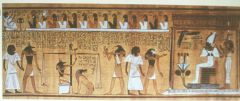
Which detail in Judgment of Hunefer Before Osiris does NOT reference the Egyptian process of mummification?
|
Hunefer kneeling before the god's of the underworld.
|
|
|
Who discovered Tutankhamun's tomb?
|
Howard Carter
|
|
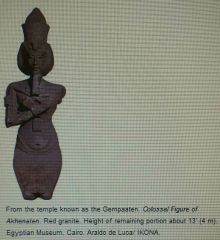
This Colossal Figure of Akhenaten demonstrates characteristics that distinguish the Amarna style in all of the following EXCEPT
|
the monumental scale of the figure.
|
|
|
Akhenaten was associated with a religion....
|
honoring a single sun deity, Aten.
|
|
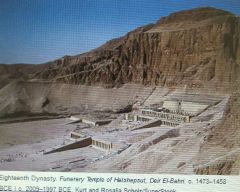
The Funerary Temple of Hatshepsut shared all of the following with Egyptian pyramids EXCEPT it....
|
did not contain the ruler's tomb.
|
|
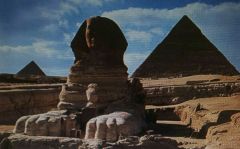
The Great Spinx at Giza shown above is a colossal portrait of which Old Kingdom ruler?
|
Khafre
|
|
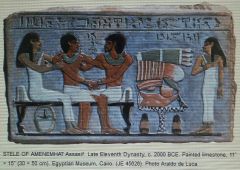
A common convention seen here in the Stele of Amenemhat is the use if darker and lighter pigment to distinguish....
|
gender.
|
|
|
What subject matter was commonly depicted in the tombs of wealthy Egyptian families?
|
Scenes of everyday life.
|
|
|
The rock-cut tombs of Beni Hasan were built during the....
|
Middle Kingdom.
|
|
|
What was the function of Egyptian canopic jars?
|
The held the major organs of the deceased.
|
|
|
The Egyptian stepped pyramid is similar to the ziggurats of Mesopotamia in....
|
height.
|
|
|
King Tutankhamun was buried in three nested coffins that identified with which Egyptian god?
|
Osiris.
|
|
|
What forced the removal of the colossal statues of Ramses II from their original location at Abu Simbel?
|
Flooding caused by construction of the Aswan High Dam.
|
|
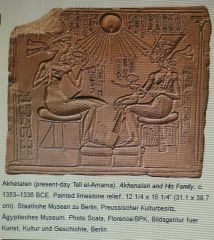
All of the following aspects of Akhenaten and his Family are specific to the Amarna style EXCEPT the....
>inclusion of the Pharaoh's children in casual poses. >prominent sun, benefitting a cult of Aten. >Pharaoh's nonidealized body. >inclusion of the Pharaoh's name in hieroglyphics. |
Inclusion of the Pharaoh's name in hieroglyphics.
|
|
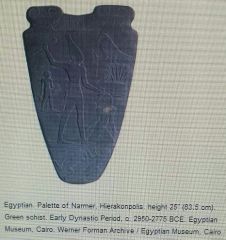
In this scene from the Palette of Narmer, Narmer is shown wearing....
|
the White Crown of Upper Egypt.
|
|
|
The earliest burial structures in ancient Egypt were called....
|
mastabas.
|
|
|
Egyptian Books of the Dead were written....
|
on papyrus scrolls.
|
|
|
The Egyptians used a canon of proportions to....
|
create an organized and ideal system for depicting human figures.
|
|
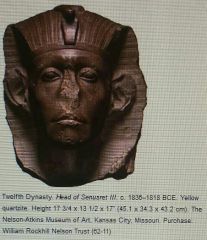
What distinguishes the Head of Senusret III as an example of Egyptian art of the Middle Kingdom.
|
Physical indications of stress and human anxiety.
|
|
|
The Rosetta Stone juxtaposes Egyptian hieroglyphics with text written in....
|
Greek.
|
|
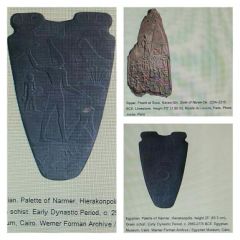
The Palette of Narmer from Egypt is similar to the Akkadian Stele of Naram-Sin in all of the following EXCEPT
>it commemorates a military victory that was historically significant. >it depicts the ruler using hierarchic scale. >it legitimizes the ruler's authority by linking him to the gods. > it organizes narrative imagery into registers. |
It organizes narrative imagery into registers.
|
|
|
Akhenaten set up at new capital at....
|
Tell el-Amarna
|
|
|
What was the ka in ancient Egyptian culture?
|
The soul or life force of an individual.
|
|

|
Woman from Willendorf
Limestone Paleolithic |
|
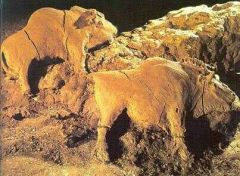
|
Bison (Le Tuc d'Audoubert)
High Relief Clay Paleolithic |
|
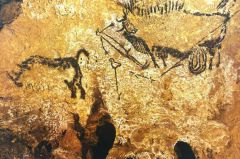
|
Bird-Headed Man with Bison (Lascaux)
Paint on limestone Paleolithic |
|
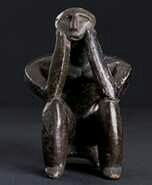
|
Figure of a man
Ceramic Neolithic |
|

|
Stonehenge
Stone Neolithic |
|
|
Paleolithic
|
Stone age
|
|
|
Relief
|
To give the impression that the sculpted material has been raised about witb background plane.
|
|
|
Megalith
|
Large stone that forms a prehistoric monument.
|
|
|
Passage Grave
|
Narrow, stone lined passageways led into a large room at the center.
|
|
|
Mesolithic
|
Culture between Paleolithic and Neolithic.
|
|
|
Sculpture in the Round
|
It is sculpted out on all sides and is not attached to anything, it is free standing.
|
|
|
Monolith
|
A large single upright block of stone, especially one shaped into or serving as a pillar or monument.
|
|
|
Neolithic
|
The later part of the stone age.
|
|
|
Pigment
|
The natural coloring matter of animal or plant tissue.
|
|
|
Shamanism
|
The belief that certain people can travel outside of their bodies in order to mediate between the world's of the living and the spirits.
|
|
|
Post-and-Lintel
|
A horizontal beam laying on top of two columns standing up straight.
|
|
|
Dolmen
|
portable tomb
|
|
|
BCE
|
Before the Common Era
|
|
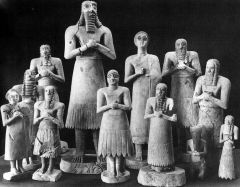
|
Votive figures
Sculpture in the Round limestone Sumerian |
|
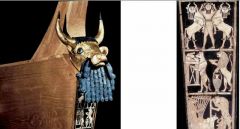
|
The Great Lyre
Sculpture in the Round Wood, Stone, Lapis Lazuli Sumerian |
|
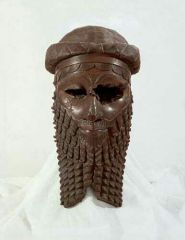
|
Head of a Man
Sculpture in the Round Bronze Akkadian |
|
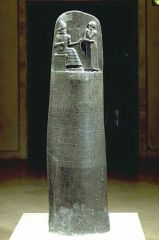
|
Stele of Hammirabi
Sculpture in the Round Basalt Old Babylonian |
|

|
Assurnasirpal II Killing Lions
Low relief Stone Assyrian |
|
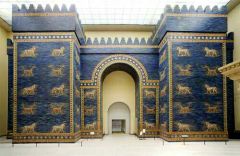
|
Ishtar Gate
Glazed Bricks Lapis Lazuli Neo-Babylonian |
|

|
Darius and Xerxes Receiving Tribute
Low Relief Stone Persian |
|
|
Mesopotamia
|
name for the area of the Tigris–Euphrates river system
|
|
|
Pictograph
|
a pictorial symbol for a word or phrase
|
|
|
Lyre
|
a stringed instrument like a small U-shaped harp with strings fixed to a crossbar
|
|
|
Glaze
|
overlay or cover with a smooth, shiny coating or finish
|
|
|
Polytheistic
|
belief in many gods
|
|
|
Cuneiform
|
wedge-shaped characters used in the ancient writing systems on clay tablets
|
|
|
Stele
|
an upright stone slab or pillar bearing an inscription or design and serving as a monument, marker,
|
|
|
Votive Figures
|
placed in the tombs to keep worshiping the Gods forever
|
|
|
Registers
|
levels used to organize and image
|
|
|
Hierarchical Proportions
|
artist uses unnatural proportion or scale to depict the relative importance of the figures
|
|
|
Apadana
|
Great audience hall
|
|
|
Ziggurat
|
rectangular stepped tower, sometimes surmounted by a temple
|
|
|
Cylinder seal
|
a small, barrel-shaped stone object with a hole down the center and an incised design or cuneiform inscription
|
|
|
Lamassu
|
Assyrian protective deity
|
|
|
Gligamesh
|
Semi Devine king of Babylon who was also in some myths
|
|
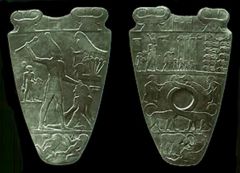
|
Palette of Narmer
Low relief sculpture Stone Predynastic |
|
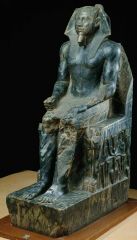
|
Seated statue of Khafre
Sculpture in the Round Stone Old Kingdom |
|
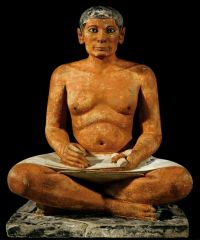
|
Seated Scribe
Sculpture in the Round Painted and Limestone Old Kingdom |
|
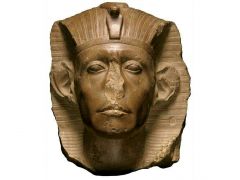
|
Head of Senusret III
Sculpture in the Round Stone Middle Kingdom |
|
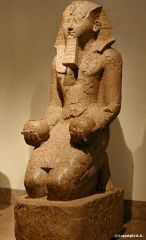
|
Statue if Hetshepsut kneeling
Sculpture in the Round Stone New Kingdom |
|
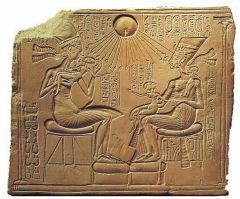
|
Akhenaten and His Family
Low Relief Stone tablet New Kingdom |
|

|
Judgement of Hunefer before Osiris
Low Relief Stone tablet New Kingdom |
|
|
Dynasty
|
a line of hereditary rulers of a country
|
|
|
Ka
|
a spiritual entity, an aspect of the individual, believed to live within the body during life and to survive it after death.
|
|
|
Pyramid
|
a monumental structure with a square or triangular base and sloping sides that meet in a point at the top, especially one built of stone as a royal tomb in ancient Egypt
|
|
|
Book of the Dead
|
is an ancient Egyptian funerary text
|
|
|
Upper Egypt
|
South
|
|
|
Pharaoh
|
a ruler in ancient Egypt.
|
|
|
Mummification
|
is a process in which the skin and flesh of a corpse can be preserved
|
|
|
Sphinx
|
a winged monster of Thebes, having a woman's head and a lion's body.
|
|
|
Hierarchical Proportions
|
the artist uses unnatural proportion or scale to depict the relative importance of the figures in the artwork
|
|
|
Lower Egypt
|
North
|
|
|
Hieroglyphic
|
designating or pertaining to a pictographic script
|
|
|
Mastaba
|
an ancient Egyptian tomb rectangular in shape with sloping sides and a flat roof
|
|
|
Sarcophagus
|
a stone coffin, typically adorned with a sculpture or inscription
|
|
|
Canon of Proportions
|
a rule of proportions
|
|
|
Hypostyle
|
having a roof supported by pillars, typically in several rows.
|
|
|
Rosetta Stone
|
a black basalt stone that bears an inscription in hieroglyphics, demotic characters, and Greek and is celebrated for having given the first clue to the decipherment of Egyptian hieroglyphics
|
|
|
Necropolis
|
a cemetery, especially a large one belonging to an ancient city.
|
|
|
Monotheism
|
belief that there is only one God
|
|
|
Composite Pose
|
Combining different viewpoints within a single representation of a subject
|
|
|
Papyrus
|
a material prepared in ancient Egypt from the pithy stem of a water plant,
|

